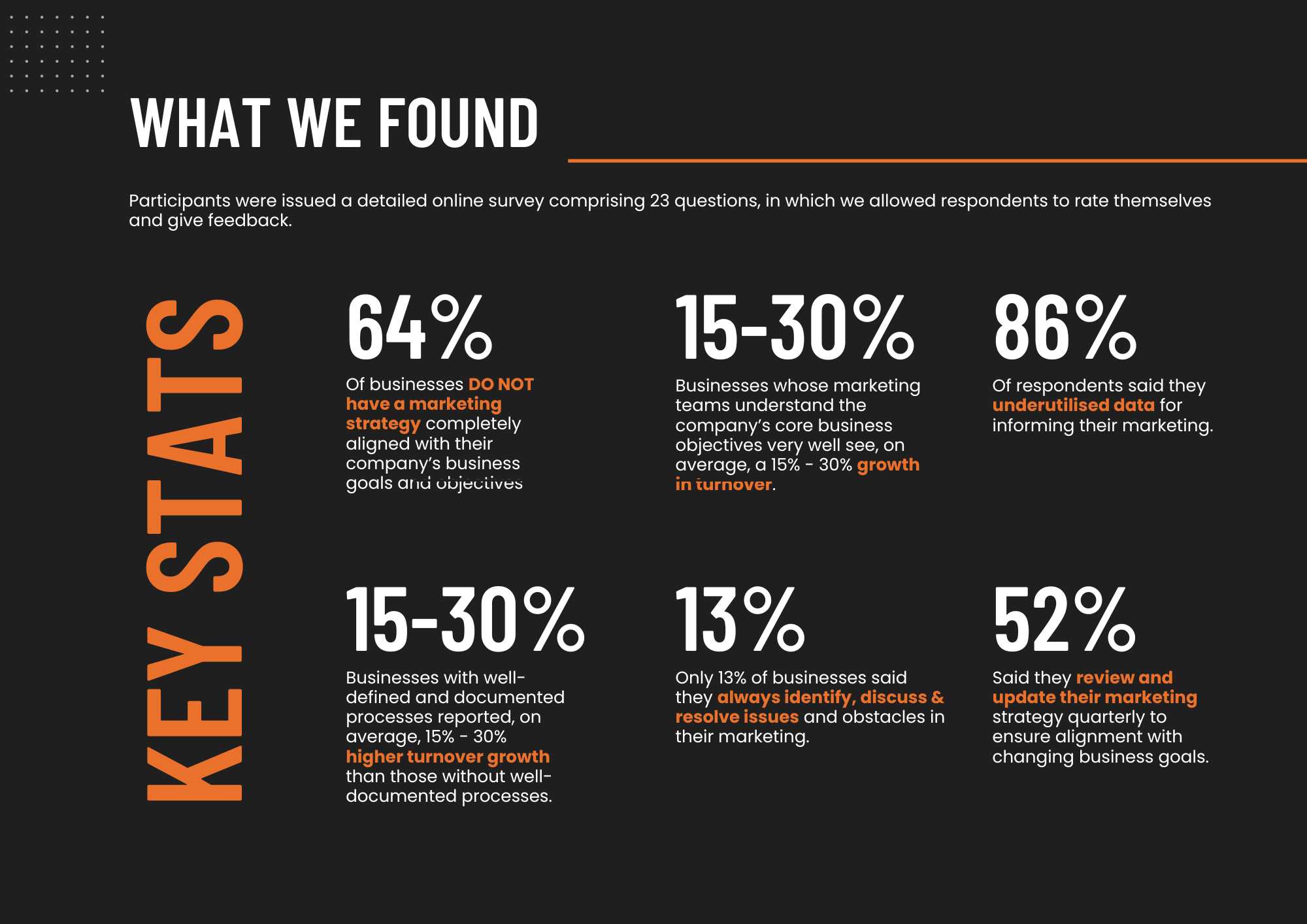Setting goals when it comes to your marketing is essential. You need to have a clear understanding of what success looks like to make sure your marketing activity is moving the needle for your business. The problem is that choosing the right goals and metrics can be hard; you want to make sure they’re easily measured, but that they also help you to achieve the overarching goals for the business.
That’s why we’ve put together a guide on how to set the right goals for your marketing strategy to ensure that you achieve more of your goals and that your business thrives as a result.
- Understanding Marketing Goals
- Strategic Planning in Marketing
- Execution and Adaptation
- Measurement and Analysis

Understanding Marketing Goals
It’s easy to view marketing goals as KPIs within their own bubble. Something that the marketing team worries about but that makes little difference outside of the department. That couldn’t be further from the truth, though. Your marketing goals should all be laser-focused and related to achieving your overall company growth objectives. When you have goals that tangibly impact the company’s performance, you’ll view them differently and with the importance they deserve.
Defining Clear Company Objectives
To set and achieve the right marketing goals, you need to ensure that you’re sharing your broader company objectives with the marketing function. It’s important that your team understands what the objective of their activity is. Without understanding the overall direction of the business, you can’t expect your team to come up with relevant goals.
For example, if you share with your marketing team that your goal is to increase your average order value from £100 to £110 per order, you’ve given them a clear objective to work towards. This will allow them to plan projects around achieving this tangible business objective and measure progress towards the goal.
Measuring Progress
Most businesses set goals with a deadline and measure the success of the project by whether or not it has been achieved on the deadline date. The problem with measuring success in this way is that you won’t have any tangible evidence that the goal is likely to be achieved or not until the deadline date. That’s why it’s important to measure progress towards the goal.
Using the example above about increasing the average order value, the overall success of the goal is going to be measured by whether or not the average order value is £110 or not by the deadline. Whilst this is ultimately the measure of success, it’s also advisable to set goals for progress along the way. That way you can see whether you’re likely to the end goal before the deadline and course correct if necessary. This is the sort of marketing goal you’d want your team to look after, whilst at a company level you may only be interested in the overall achievement.
Leading vs Trailing Metrics
There are two types of metrics to track when looking at marketing goals. They are leading and trailing metrics.
Leading Metrics – Activity that leads/contributes to the attainment of a goal. For example, increasing the number of products people view when on the website is likely to lead to a larger number of items purchased in each transaction.
Trailing Metrics – Objectives that are achieved as a result of your leading activity. These metrics are typically your most important outcomes, such as sales, leads or order value.
By tracking your leading metrics, as well as your trailing metrics, you’re more likely to achieve your overall goals because you’re doing the things that make them happen.

Strategic Planning in Marketing
Marketing is an essential component of any business, and a well-executed marketing strategy can help a company achieve its goals. Strategic planning in marketing involves developing a comprehensive plan that outlines the steps a business will take to achieve its marketing objectives. This section will discuss the key elements of strategic planning in marketing, including developing a marketing plan, budget allocation, and resource management.
Developing a Marketing Plan
Developing a marketing plan is the first step in strategic planning for marketing. It involves identifying the business’s marketing goals, target audience, and marketing mix. The marketing mix includes product, price, promotion, and place. A marketing plan should be comprehensive and include all the necessary components to achieve the desired marketing objectives.
To develop a marketing plan, a business should conduct market research to understand its target audience and competition. This research can help a business identify its unique selling proposition and develop a marketing strategy that differentiates it from competitors. A marketing plan should also include a timeline and budget for each marketing activity.
Budget Allocation and Resource Management
Budget allocation and resource management are essential components of strategic planning in marketing. A business should allocate its marketing budget based on the expected return on investment (ROI) of each marketing activity. A marketing activity with a high ROI should receive a higher budget allocation than a marketing activity with a low ROI.
Resource management involves managing the resources required to execute the marketing plan successfully. This includes managing the marketing team, 3rd party partners, and technology resources. A business should ensure that it has the necessary resources to execute the marketing plan effectively. This includes hiring the right people, outsourcing to the right 3rd parties, and investing in the right technology.
In conclusion, strategic planning in marketing involves developing a comprehensive marketing plan, allocating the marketing budget based on ROI, and managing the resources required to execute the marketing plan successfully. A well-executed marketing strategy can help a business achieve its marketing objectives and ultimately contribute to its overall success.

Execution and Adaptation
Implementing Marketing Strategies
Executing marketing strategies is crucial to achieving goals. The most effective teams make execution a habit by motivating themselves to stay on top of the work that matters and remain accountable for their goals. To achieve this, companies need to instil a culture of transparency by fostering visibility into goal progress, priorities, and potential blockers. This can be done by initiating meaningful conversations and encouraging feedback and collaboration.
Monitoring Progress and Making Adjustments
Monitoring progress is essential to achieving goals. The most effective teams monitor their progress regularly and make adjustments accordingly. This can be done by setting up key performance indicators (KPIs) and tracking them regularly. KPIs can be used to measure progress towards goals and identify areas that need improvement.
Making adjustments to marketing strategies is crucial to achieving goals. Companies need to be flexible and willing to make changes to their strategies when necessary. This can be done by regularly reviewing their strategies and making adjustments based on the results. Companies can also learn from their competitors and adapt their strategies accordingly.
In summary, executing marketing strategies and adapting them to the results are crucial to achieving goals. Monitoring progress regularly and making adjustments accordingly is also essential. Companies that are flexible and willing to make changes to their strategies when necessary are more likely to achieve their goals.

Measurement and Analysis
When it comes to achieving marketing goals, measurement and analysis are essential components. They help businesses understand what is working and what isn’t, allowing them to adjust their strategies accordingly. In this section, we will explore two key aspects of measurement and analysis: Key Performance Indicators (KPIs) and learning from analytics and feedback.
Key Performance Indicators
KPIs are measurable values that indicate how well a business is achieving its objectives. They are critical for tracking progress towards goals and identifying areas for improvement. The KPIs that a business chooses to measure will depend on its specific goals and objectives. For example, if a business’s goal is to increase website traffic, its KPIs might include the number of unique visitors, page views, and bounce rate.
It is essential to choose KPIs carefully to ensure that they accurately reflect progress towards goals. Additionally, it is crucial to track KPIs consistently over time to identify trends and patterns. Businesses can use various tools, such as Google Analytics, to track KPIs and gain insights into their marketing performance.
Learning from Analytics and Feedback
Analytics and feedback are essential for understanding how well marketing efforts are performing. Analytics provide businesses with valuable insights into customer behaviour, such as how customers interact with a website or respond to marketing campaigns. Feedback, on the other hand, provides businesses with direct input from customers.
By combining analytics and feedback, businesses can gain a comprehensive understanding of their marketing performance. They can identify areas for improvement and adjust their strategies accordingly. For example, if a business receives feedback that its website is difficult to navigate, it can use analytics to identify the pages that are causing the most problems and adjust them accordingly.
In conclusion, establishing goals and proper measurement and analysis are critical for achieving marketing goals. By choosing the right KPIs and learning from analytics and feedback, businesses can gain valuable insights into their marketing performance and make data-driven decisions to improve their strategies.
Download our Vision Advantage report where we discuss this in further detail, having gained key statistics from hundreds of businesses.

Posted in Advice, Digital Marketing
